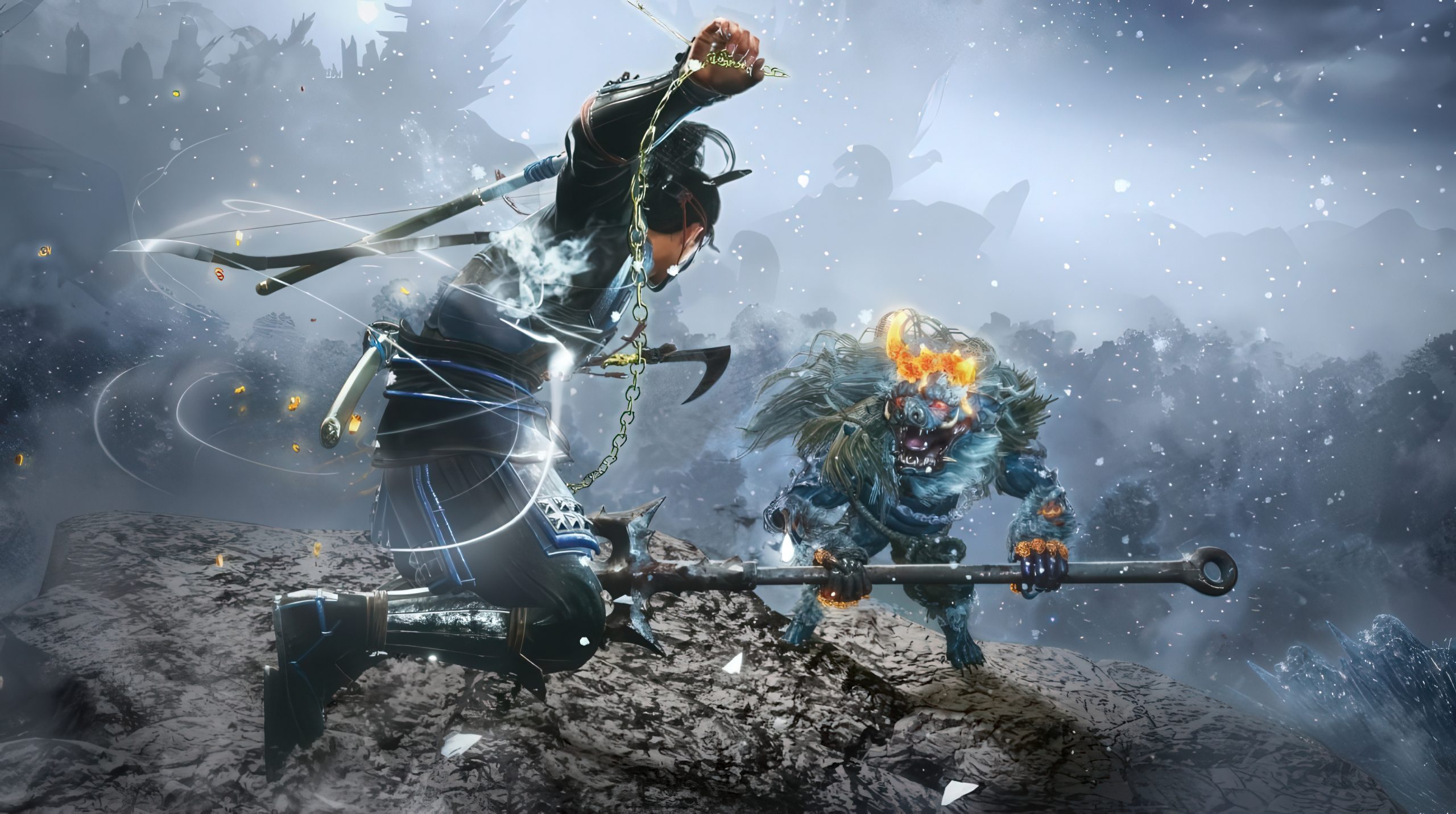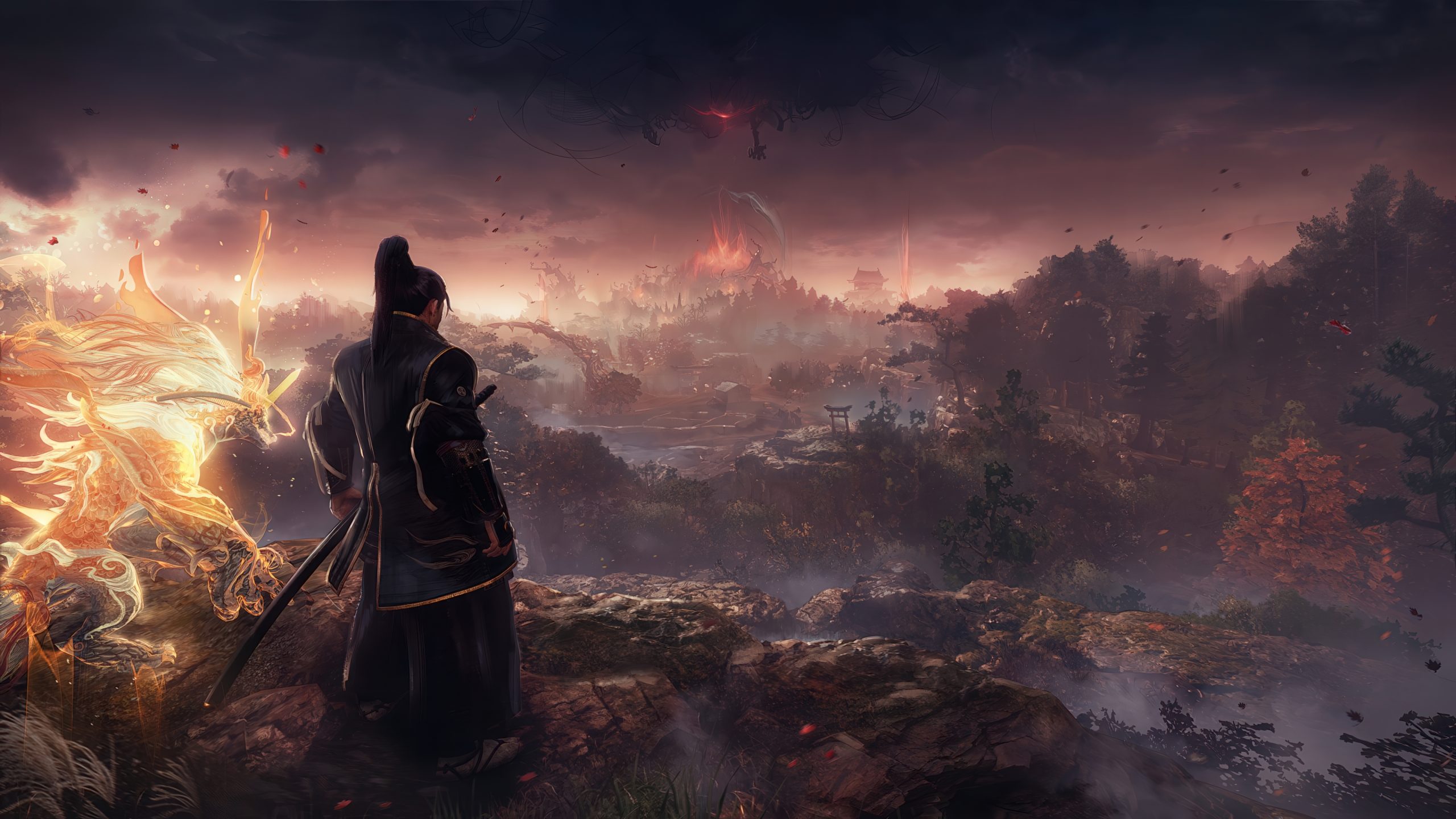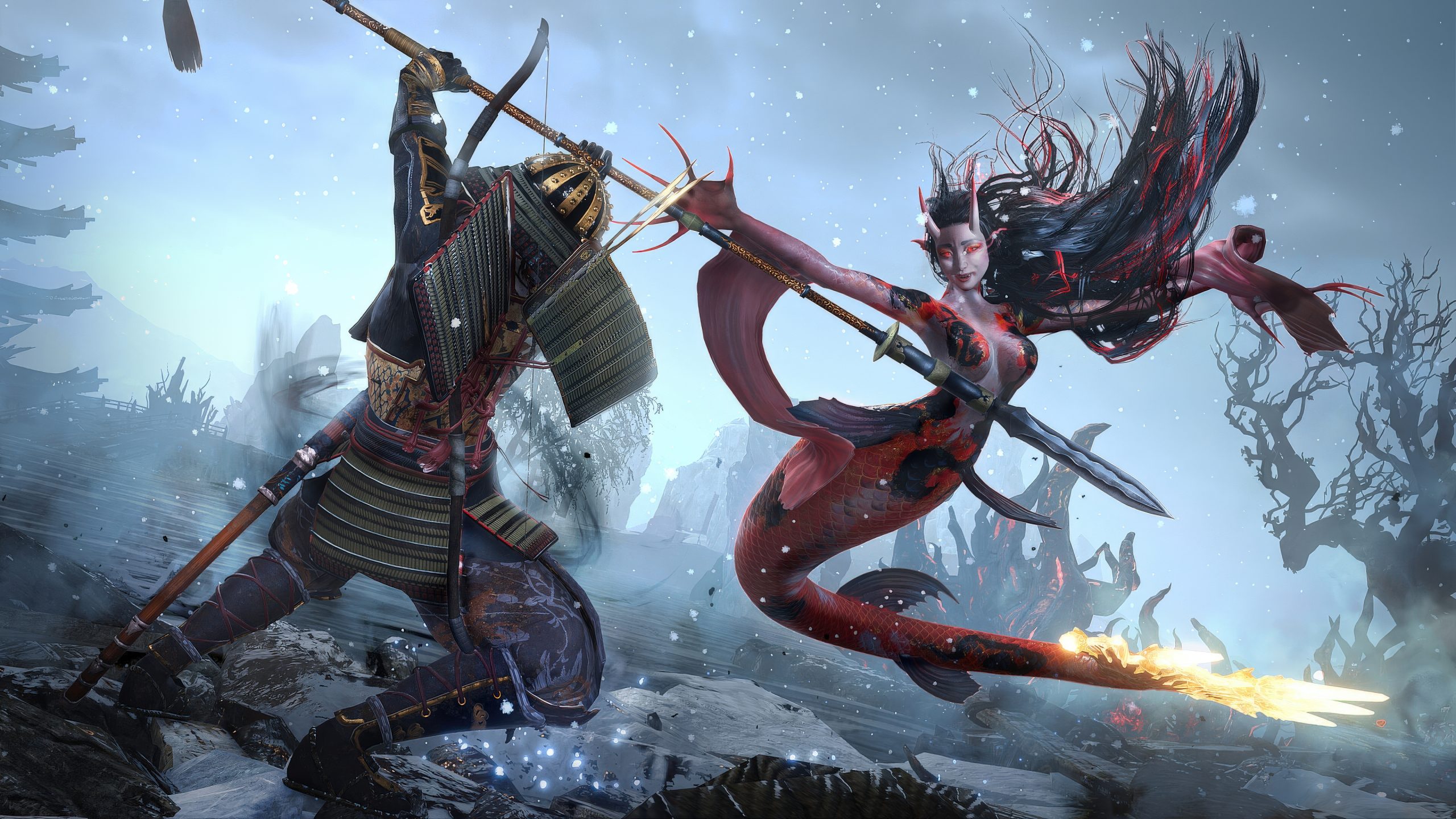What was once a slice of alternative history with a Irish prisoner escaping the Tower of London and becoming an influential samurai in the first Nioh title has expanded now into a story of time travel and dual identity. Nioh 3 aims to reinvent the tale that Team Ninja has told over the past eight years with a new time period and setting.
As the grandson of shogun Tokugawa Ieyasu, players assume the role of a samurai whose unique set of skills allows them access to two completely different playstyles. With the Samurai playstyle, players engage in combat like William did in the first game, complete with multiple stances available for each weapon and a Ki Pulse maneuver to regain expended stamina. Playing as a Ninja, on the other hand, removes the stances completely and instead gives the player access to various ninjutsu and ninja tools to approach the combat with surprise attacks and less head-on assaults. Swapping between these two is a simple affair during combat, although I found myself sticking more to the tried-and-true Samurai style because of all of the muscle memory from the two previous Nioh titles. Unfortunately, weapon types are locked between the two combat styles for reasons that Nioh 3 Producer Kohei Shibata mentioned in our interview below.
Much like earlier Nioh titles, enemies are literal fountains of loot with showers of weapons and gear of various rarities that pool forth and litter the screen. New loot filters allow players only to seek out higher rarity tiered items and automatically destroy/sell lower ranked gear that would otherwise clutter their inventory. While this doesn’t solve the issue of a lack of bespoke, unique items, it does at least push the player only to seek out stronger gear that would come with a potentially better roll of abilities.
Nioh 3 doesn’t pull any punches in terms of combat this time around either. Facing the bosses at the end of the Tokyo Game Show demo was an exercise in frustration and learning the intricacies of defensive abilities as Takeda Shingen wails on the player. Despite the challenges, this fight was a fantastic way to immerse players in the combat changes to Nioh 3 and allow them to use every ninja tool in their arsenal to best the boss. If other fights in Nioh 3 can match the intensity of this single fight, I’m looking at another 100-hour obsession when this finally launches on PlayStation 5 and PC next year on February 6, 2026. We couldn’t get a good peek into the time travel this time around, but that’s something to keep our eyes open for in the months to come.
After getting thoroughly worked by Takeda Shingen’s demonic form, we had the pleasure of sitting down with Nioh 3 Producer Kohei Shibata for an intimate 1-on-1 interview, translated by one of Koei Tecmo’s in-house interpreters.
 One of the reasons that we came to the time travel idea for this game is that with Nioh 3, one of the things that I wanted to challenge was having an open field. Basically, the open field was the starting point of how we got to this time-travel idea. The reason behind that is when thinking of ways that we show the open field, we wanted to make sure that players would be able to recognize that there are different areas of the field. One effective way of portraying this is by showing a completely different time period.
One of the reasons that we came to the time travel idea for this game is that with Nioh 3, one of the things that I wanted to challenge was having an open field. Basically, the open field was the starting point of how we got to this time-travel idea. The reason behind that is when thinking of ways that we show the open field, we wanted to make sure that players would be able to recognize that there are different areas of the field. One effective way of portraying this is by showing a completely different time period.
Why go with these time periods in Japanese history specifically for Nioh 3?
With Nioh 3, we decided that we wanted to go with the idea of traveling through time. While in the past, we have focused on the Sengoku, or Warring States, Period and focused on major events in that period. Various major characters or historical figures have been included at key points within the story. This time, we wanted to use traversing through time as a key idea, but for the story, we would incorporate the Sengoku Period as well. For the start of the story, it might be better to start with something a little bit different than what people would expect. We decided to, rather than start from a period of war and battles, we wanted to start from a peaceful period, and from there, the protagonist ends up against the wall in terms of being targeted, and this leads to being able to travel through time, so then we can visit the various periods within Japanese history.
When you were creating the first Nioh title with William as the protagonist, did you already have plans for the story to evolve into time travel?
No, it wasn’t something that we had in mind from the first game. We didn’t have this mapped out at all. One of the reasons that we came to the time travel idea for this game is that with Nioh 3, one of the things that I wanted to challenge was having an open field. Basically, the open field was the starting point of how we got to this time-travel idea. The reason behind that is when thinking of ways that we show the open field, we wanted to make sure that players would be able to recognize that there are different areas of the field. One effective way of portraying this is by showing a completely different time period.
We’re using time travel to really showcase the open field element of Nioh 3, so we’ve incorporated that into the story. I guess I gotta say we got a little bit of a hit of this from the DLC for Nioh 2 because one of the DLCs does go through time.
The Nioh series has predominantly been mission-focused, but in titles like Rise of the Ronin, it was largely open world with smaller discrete missions. When transitioning from a mission-based design to an open world, how do you keep that feeling structured and created in a specific way?
One thing when creating this game that we really wanted to make sure that we kept to is that we wanted to make sure that there was freedom and exploration within the field. We wanted to make sure that we had that ability given to the player, but also at the same time, when they pick it up, they’ll instantly realize that Nioh 3 feels like a Nioh game. It’s this dark action RPG, but in terms of how we would portray it, we kept an eye on the density of the fields created and kept that feeling of tension throughout.
Not to say that it was easy, obviously. We went through a lot of trial and error. At one point, we were trying to keep it as an intense action game, but we had just too many enemies on the field. We found that just trying to defeat them gets a little bit tiring. You couldn’t really feel a difference, and it just felt like the same thing over and over again. We decided to formulate it in a way that you’ll encounter areas on the field that have a lot of enemies, but you might encounter a few enemies, but they’re very strong. On the other hand, you’ll also have an area that’s harder to get through. We wanted to make sure that players know there are various ways to progress.
We incorporated a sort of mission, or various strategic ways that you can choose which path you want to go in order to clear the game. We want to make sure that we have that balance in the game as well. In the end, we have given players a lot of different options in how they can explore and get through the various missions, but in the end, when they play it, they’ll definitely feel that this is a Nioh game.
 At one point, we were trying to keep it as an intense action game, but we had just too many enemies on the field. We found that just trying to defeat them gets a little bit tiring. You couldn’t really feel a difference, and it just felt like the same thing over and over again. We decided to formulate it in a way that you’ll encounter areas on the field that have a lot of enemies, but you might encounter a few enemies, but they’re very strong. On the other hand, you’ll also have an area that’s harder to get through.
At one point, we were trying to keep it as an intense action game, but we had just too many enemies on the field. We found that just trying to defeat them gets a little bit tiring. You couldn’t really feel a difference, and it just felt like the same thing over and over again. We decided to formulate it in a way that you’ll encounter areas on the field that have a lot of enemies, but you might encounter a few enemies, but they’re very strong. On the other hand, you’ll also have an area that’s harder to get through.
Masocore (Masochism Hardcore) has been an identity of the Nioh series. You’ll have veterans who are very comfortable with this type of difficult action, but there will also be new players who are playing Nioh 3 for the first time in the series. How do you balance where you want to challenge veteran players while also making the game accessible for new players?
The first thing I want to say is that the enemies themselves have not become weaker and they’re still very strong. I think that in terms of Nioh 3, in order to defeat those enemies, players will have to reach a level where they can defeat them.
We’ve incorporated elements such as player growth, skill growth, as well as being able to learn the game systems. As players learn the system mechanics, they’ll catch on to how to defeat the enemies. We’ve made sure that it’s easier to learn as you play, so we do have tutorials in Nioh 3. We have onboarding elements as well incorporated into the main structure of the game. Even though the enemies themselves remain powerful, those who are new to the game won’t be able to instantly defeat them but as they play through Nioh 3, they’ll understand the mechanics and ways to defeat them so that it isn’t a frustrating experience. For those who are used to the series, they can get right into Nioh 3.
One of the changes that we’ve done is with the Samurai Style. In previous games, you were instantly given the different stances of High, Mid, and Low. This time, when you start the game off as a Samurai, you’ll start with just the Mid stance so that you can learn the mechanics and get used to it and then learn the other stances so that you’re not instantly overwhelmed. For players who haven’t played in a while, maybe they just need a reminder on how to get into the game. We’ve retained the difficulty level of the Nioh series, but we’ve given players the opportunity to be able to overcome the game and skill up in a fair way.
With Nioh 3 having two different combat styles, I did see that weapon types were segregated between the two styles. Does that mean that the Samurai style will not be able to use the Tonfa or Kusarigama?
Essentially, no, you cannot switch between the two. When we came up with the Ninja and Samurai styles, we also decided on the weapons that would match that image of a Ninja. Up until now, Nioh has only had Samurai in it. This might be more because I’m Japanese and it’s our intrinsic feeling, but it’s about what kind of weapons we would see. The Tonfa and Kusarigama were very common for Ninjas, but we don’t have that image for Samurai or didn’t think that it would be fitting for a Samurai to be able to use those weapons. Even for things like Spears, you know that Samurai would use them, but not a Ninja. But for weapons like the Katana, that’s something that both Samurai and Ninja have used and wield a single, or even double blade. That is one common weapon between the two, but even with the same weapon, the way they use it is quite different. A Samurai might hold the weapon up above their head, whereas Ninjas would hold it behind them in a different style. Even though it’s the same weapon, how they use it is quite distinct but also fitting for that style.
As a veteran Nioh player, I typically play with a Kusarigama in High stance, so with that weapon being limited to the Ninja style, I have to relearn that weapon with a new moveset. I understand, and it was the dev team’s decision to do things like that. We apologize for that, but if you could use a weapon in either style, the distinct elements between the two Styles would be a little bit muddled. We wanted to make sure to keep the two Styles distinct and one of the ways was in the weapon selection.
 Essentially, no, you cannot switch between the two weapon styles. When we came up with the Ninja and Samurai styles, we also decided on the weapons that would match that image of a Ninja. […] We apologize for that, but if you could use a weapon in either style, the distinct elements between the two Styles would be a little bit muddled. We wanted to make sure to keep the two Styles distinct and one of the ways was in the weapon selection.
Essentially, no, you cannot switch between the two weapon styles. When we came up with the Ninja and Samurai styles, we also decided on the weapons that would match that image of a Ninja. […] We apologize for that, but if you could use a weapon in either style, the distinct elements between the two Styles would be a little bit muddled. We wanted to make sure to keep the two Styles distinct and one of the ways was in the weapon selection.
Onmyo Talismans have been very powerful in previous Nioh titles, and I was wondering if they will still be as powerful in Nioh 3. Will you be rebalancing those, or have players play with less of a focus on that playstyle?
The Talismans are still in and we have made some adjustments. They are overall powerful and we have made some adjustments, but it’s not to the extent that they seem a lot weaker or stronger than in pervious games. One thing that has changed is how you obtain Talismans. In Nioh 3, you obtain them by defeating Yokai.
Nioh games have a lot of equipment you can gather; some say the loot is quantity over quality. When you’re going through a level and you have 20 different Katanas dropping, how do you make it feel like players want to upgrade and look for new equipment?
One thing that we’ve done is make it easier to handle or look at your stock of weapons. One of the new features you can set is that the most powerful weapon in your possession is automatically equipped. We’ve also added a setting so that if something drops and it’s below a certain rarity, you can automatically sell it off or get rid of it. You can immediately tell what is of the most value and what isn’t. It should be easier to get through the quantity.
Another thing that we’ve done with Nioh 3 is because of the two Styles. For example, with the Ninja style and Ninpo, you can find equipment with stronger effects. We’ve given players an incentive to look for these things and equip them to become stronger.
Once you finish Nioh 3, will you unlock a higher difficulty level?
Yes, we have incorporated that into a second playthrough where you can increase the difficulty level and I think that has become a staple for the Nioh series.
Thank you very much for your time.
Follow Wccftech on Google or add us as a preferred source, to get our news coverage and reviews in your feeds.


AloJapan.com